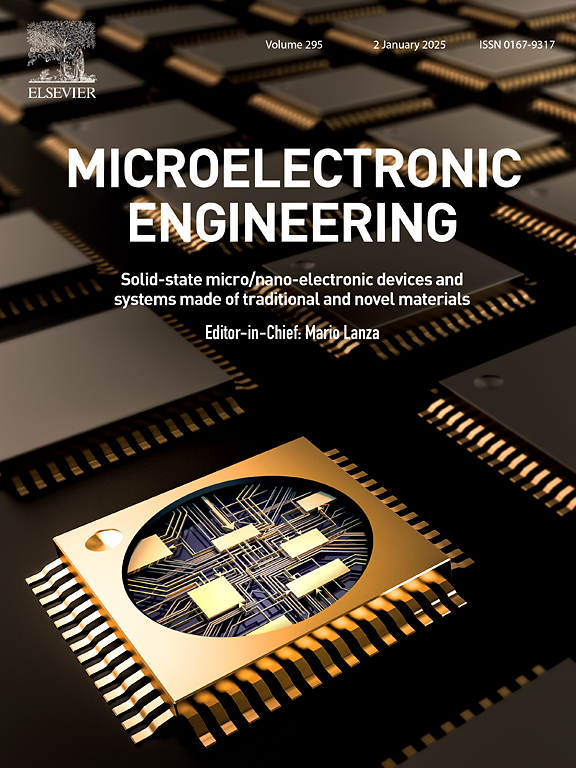Optimization of edge bead removal (EBR) process to enhance defect reduction in optical lithography
IF 3.1
4区 工程技术
Q2 ENGINEERING, ELECTRICAL & ELECTRONIC
引用次数: 0
Abstract
Defect reduction remains a critical objective in the integrated circuit manufacturing process, particularly within the highly re-entrant lithography modules where minimizing defects is crucial. Defects at the wafer edge can contaminate lithography modules and downstream processing equipment, leading to redistribution onto the wafer surface and adversely affecting overall device yield. A persistent challenge in the resist coating process is the formation of resist edge beads, driven by the strong Van der Waals attraction of excess photoresist (PR) to itself and the underlying substrate. The edge bead removal (EBR) process is a standard cleaning step designed to eliminate these edge beads and prevent potential contamination.
In this study, we identify the sources of EBR induced defects and additional EBR process encroachment toward edge patterning during the EBR cleaning process. This study provides a comprehensive study aimed at optimizing the EBR cleaning process to effectively eliminate EBR-induced defects, thereby enhancing overall device yield. Specifically, we identify three primary defects induced by the EBR cleaning process: rainbow-type, finger-shaped, and teardrop-type defects. Our experimental study reveals that in addition to EBR rinse time, PR cast time is crucial parameters contributing to the formation of these defects. By properly optimizing the PR cast time and EBR rinse time, we were able to remove nearly 100 % of dense clusters of defects that were easily visible even at low magnification optical microscopy throughout the wafer edge. We observed that shorter PR casting times shows edge defects caused by inefficient EBR process because of insufficient time for PR to fully settle causing superfluous PR to continue flowing toward wafer edge during EBR clearing step, leading to partial removal of PR at the wafer edge and the formation of rainbow defects. Proper optimization of both PR casting time and EBR chemistries dispense time is essential to resolve these defects, ensuring efficient EBR cleaning process and improved overall device yield.

边珠去除(EBR)工艺的优化,以提高光刻中缺陷的减少
减少缺陷仍然是集成电路制造过程中的一个关键目标,特别是在高度可重复使用的光刻模块中,最大限度地减少缺陷是至关重要的。晶圆边缘的缺陷会污染光刻模块和下游加工设备,导致重新分布到晶圆表面,并对整体器件良率产生不利影响。在抗蚀剂涂层过程中,一个持续的挑战是由过量光刻胶(PR)对自身和底层基材的强烈范德华吸引力驱动的抗蚀剂边缘珠的形成。边缘珠去除(EBR)过程是一个标准的清洁步骤,旨在消除这些边缘珠和防止潜在的污染。在这项研究中,我们确定了在EBR清洗过程中,EBR引起的缺陷和额外的EBR过程对边缘图案的侵蚀的来源。本研究对优化EBR清洗工艺进行了全面的研究,以有效消除EBR引起的缺陷,从而提高整体器件良率。具体来说,我们确定了由EBR清洁过程引起的三种主要缺陷:彩虹型、手指型和泪滴型缺陷。我们的实验研究表明,除了EBR冲洗时间外,PR浇铸时间是导致这些缺陷形成的关键参数。通过适当优化PR浇铸时间和EBR冲洗时间,我们能够消除几乎100%的密集缺陷簇,即使在整个晶圆边缘的低倍率光学显微镜下也很容易看到。我们观察到,较短的PR浇铸时间显示了由于EBR工艺效率低下导致的边缘缺陷,因为PR没有足够的时间完全沉淀,导致多余的PR在EBR清除步骤中继续流向晶圆边缘,导致晶圆边缘部分PR去除,形成彩虹缺陷。适当优化PR浇铸时间和EBR化学剂分配时间对于解决这些缺陷至关重要,从而确保高效的EBR清洗过程和提高整体设备良率。
本文章由计算机程序翻译,如有差异,请以英文原文为准。
求助全文
约1分钟内获得全文
求助全文
来源期刊

Microelectronic Engineering
工程技术-工程:电子与电气
CiteScore
5.30
自引率
4.30%
发文量
131
审稿时长
29 days
期刊介绍:
Microelectronic Engineering is the premier nanoprocessing, and nanotechnology journal focusing on fabrication of electronic, photonic, bioelectronic, electromechanic and fluidic devices and systems, and their applications in the broad areas of electronics, photonics, energy, life sciences, and environment. It covers also the expanding interdisciplinary field of "more than Moore" and "beyond Moore" integrated nanoelectronics / photonics and micro-/nano-/bio-systems. Through its unique mixture of peer-reviewed articles, reviews, accelerated publications, short and Technical notes, and the latest research news on key developments, Microelectronic Engineering provides comprehensive coverage of this exciting, interdisciplinary and dynamic new field for researchers in academia and professionals in industry.
 求助内容:
求助内容: 应助结果提醒方式:
应助结果提醒方式:


